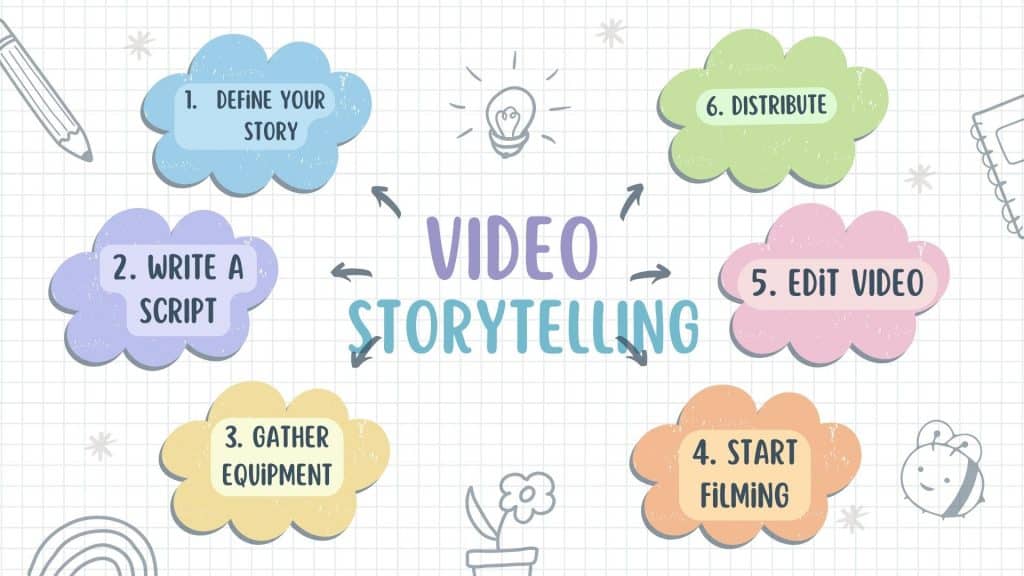Video storytelling is taking over the marketing world and for good reasons. One of which is because it has the power to create a deeper connection with your audience and it is a visually engaging way to share your brand’s story.
I can remember growing up as a child, I enjoyed video storytelling as compared to other means of telling stories, this is because it allows one to see the exact image and idea of the story, rather than imagining what it looks like in my subconscious.
With the growing number of distractions, one may find it difficult to capture people’s attention when sharing information. But when you add a video to the story or information you want to get across to the public, people are more likely to be focused.
Now, let’s take a look at what video storytelling is, and how you can effectively use it as a means to share information or ideas about your business to your listeners and consumers.
Read Also: SENSORY MARKETING: Best Strategies To Boost Your Brand Experience
What is Video Storytelling?
In recent times, business owners have been faced with difficulties in sharing large amounts of information and advertisements. It’s important to find a way to always stand out, as a business owner to get the attention of your designated consumers. That’s where video storytelling comes in.
Video storytelling is a major means of educating, entertaining, and making your audience want to come back for more. It brings life to your ideas, brand purpose, and personality. With it, you don’t only tell but also show.
Some years back, I was asked to train the new employees of the company where I worked. During the training, I used materials like conference guides, magazines, and writing materials (whiteboard, ink, etc). The objectives of this training were not met, as the new employees were so distracted, while a lot of them fell asleep, due to how boring the class was.
After getting to know about video storytelling, I immediately adopted the method to train another batch of new employees. Before the training, I prepared my lecture notes into a video, including characters, images, sounds, and music.
The classes were so educational, full of great tips that were inspiring, and my audience was focused on the lesson with no form of distractions. In the end, the new intakes were ready to try out something new, being fully equipped with the necessary tools they needed to resume their job assignment.
Using video to share information or ideas and maybe to tell a story engages all the senses – eyes, mind, and heart – which makes the message more powerful and immersive, and very effective in driving engagement.
Read Social Media Engagement: 7 Interactive Post Ideas That Helped Us.
Let’s take, for example, traditional journalism and multimedia journalism. Traditional journalism is the process of gathering and sharing information using media such as radio, broadcast television, cable and satellite, print, and billboards, while in multimedia journalism, information is shared using two or more media formats via the internet.
A multimedia story uses video, images, or audio (or a combination of all three) to tell a story. Also, multimedia stories can include data visualizations, infographics, slideshows, social media posts, interactive maps, animations, and many other kinds of visual and audio elements.
Now that you know what the term video storytelling means, let’s see its benefit to your business.
Benefits of Video Storytelling to Your Business
From increasing brand awareness to driving sales, the benefits of adopting video into your marketing strategy are countless. Let’s see a few:
#1. Increased brand awareness and reach
Whether you’re sharing videos on your social media platforms, website, or through digital advertising, video content has the potential to spread quickly and reach a large number of people.
This is one of the biggest benefits of video storytelling. Video storytelling can increase your brand awareness and reach. You can showcase your brand creatively and engagingly using video storytelling, which also helps to get the attention of both old and new customers. By doing so, your product gets a wider range of audience.
For example, Coca-Cola’s “Share a Coke” campaign features videos showing personalized labels on Coca-Cola bottles. The campaign encourages customers to share a Coke with someone special and promotes the brand as a fun and social product.
#2. Increased conversions and sales
This benefit of video storytelling is very realistic in the sense that video storytelling can grow conversions and sales. Using captivating and convincing videos, you can drive more traffic to your website and convert viewers into customers. Video content can be used for product demonstrations, as well as promotional content, as it presents everything about your product in a visual form. This also includes the benefits of your product and services.
Whether you’re looking to promote a new product launch, or to drive more sales, adopting video storytelling into your marketing strategy is an effective way to increase conversions and boost your bottom line.
Let’s see this example, Amazon’s animated sales video showing their Amazon One offering. the focus of this video is singular and that’s what makes it unique, it engages viewers and builds emotional connections while increasing conversions and sales.
#3. Better SEO
One thing video storytelling does for your business is that it betters your SEO efforts. Google, as well as other search engines, give more significance to video content in their ranking algorithms. This means that, when you include video content in your website, you enhance search engine visibility and draw more organic traffic to your site. Also, video content helps to increase the number of time people spend on your site, which also increases your search engine presence.
See, for example, the ads on Amazon Business. The video tells the story of an ancient Roman character using Amazon Business tools to build a city, showcasing platform features like this, it engage viewers, builds emotional connections, and increases the number of time people spend on your site while trying to find out how to build a city.
Read Also: HOW TO MEASURE BRAND AWARENESS: Tips To Improve Your Brand Strategy
#4. Increased ability to recall Brand
Video has the unique ability to create a lasting impression on viewers. This can help increase brand recall and memorability, thereby promoting brand awareness. Whether it is funny, inspiring, or educational content, videos can capture the attention of your audience and leave a lasting impression.
The above video showcases various company employees using Canva for different purposes. This will encourage viewers to use it for their design projects together with their teams when the need arises.
Principles in Video Storytelling
The first step in the video storytelling process is to address these primary questions:
- The Plot: What is the story or message you want to tell? What is its structure?
- The Purpose: Why do you want to tell this story, what’s the need to share the information with the audience or viewers, and afterward, what are the viewers expected to respond?
- The People: The main characters in your video story, who are they and how do they relate to your audience?
- The Place: What’s the main location and setting for the video, and how does it contribute to telling the story?
- The Audience: Choose your viewers. This involves the first person or persons the message is meant for. Who will first see this video? Will they be new customers, potential customers, employees, or another group?
- The method of Distribution: How do you intend to share the video story with others, and where will it be organized? For example, will it be shared on YouTube, your website, or elsewhere?
Please note that effective stories should include an introduction, conflict or complication, and resolution. Below is a checklist of the principles of Video Storytelling.
Video Storytelling Tips
Most times, it can be difficult to know where to start when creating a video story. Before you get started, keep these video storytelling tips in mind to enhance the video’s plot and mood, and to grab the audience’s attention and hold it:
#1. Use Humor to Engage Your Audience
Humor can be uncommon, especially in the B2B sector, but it can also be very helpful. This is often seen in most professions where one may expect a more formal atmosphere. In the end, you’re still talking to people, so try to make them laugh. This will help them remember you and the message you shared and also create a positive impression on your brand.
#2. Be Creative With Video Storytelling
Start with the main message, that is, the major point you wish to share, then think of unique ways you could get it across. If you come up with new ideas, then you can be sure that your viewers will be wowed.
#3. Don’t just Tell, Show
Instead of saying it aloud, use music and images to explain the point you want to make in your story. Imagine how different elements like colors, audio, angles, and more, all work together to create a feeling.
Please don’t hit people over the head with your product (unless it’s a demo video, of course). If you’re creating a story video, include your product where it fits naturally, don’t force your product into places it doesn’t belong.
#4. Create Stories To include a Beginning, Middle, and an End
Before you start, figure out what they are. Ideally, you should try to imagine the story and prepare a script, ahead of time. This will help you identify possible issues before you start filming.
#5. Be Careful not to Run with the First Thing That Comes to You
Take time to think about different options and get the obvious ones out of the way. Try thinking it through over again to make sure there are no bad ideas. Assess the selected ideas, and their ability, figuring out how they would work. Start with implementing.
Note: When you give yourself and your team the freedom to be creative, you will often come up with your best ideas.
#6. Keep Your Story Short and Straight to the Point:
Short stories can be just as engaging as long ones, plus they have a better chance of holding your viewer’s attention from beginning to end of the video. Don’t make the mistake of believing the longer the longer the video, the better. You don’t need a long time to tell a story.
#7. Tell One Story at a Time
Concentrate on the story you are telling, and avoid trying to tell too many stories at once. Video storytelling is the most successful when it follows a clear and concise storyline.
You can consider these tips next time you’re working on a brand video. Whether you’re storyboarding or scripting, they’re sure to provide some food for thought.
Now let’s take you through how you can tell your story using video.
Guide to Tell a Story Using Video:

Here is an easy step-by-step guide to help you tell a captivating and engaging story using video:
#1. Define Your Story:
Before you start filming, it’s important to have a clear understanding of the story you want to tell. What is the main message or theme? Who are the characters involved? What is the beginning, middle, and end of your story?
#2. Scripting:
Write a script that outlines the dialogue, narration, and key scenes of your video. This will serve as a guide for your filming process and ensure that your story is in order and engaging.
#3. Storyboarding:
Create a storyboard to visually plan out each shot of your video. This can be a series of sketches or images that represent each scene. Pay attention to composition, camera angles, and transitions between shots.
#4. Gathering Equipment:
Depending on your budget and resources, gather the necessary equipment for filming. This may include a camera (or smartphone), tripod, microphones, lighting equipment, and any other accessories you may need.
#5. Filming:
Once you have your script, storyboard, and equipment ready, it’s time to start filming. Pay attention to details such as lighting, sound quality, and framing to ensure that each shot looks professional and contributes to the overall story.
#6. Editing:
After filming is complete, import your footage into video editing software. Arrange your shots according to the script and storyboard, and begin the editing process. This may involve cutting unnecessary footage, adding transitions, incorporating music and sound effects, and adjusting color and lighting.
#7. Adding Text/Graphics:
Depending on the style of your video, you may want to include text overlays, graphics, or animations to enhance the storytelling experience. Use these elements carefully and strategically to enhance your story.
#8. Review and Revision:
Once you have a rough cut of your video, review it carefully and make any necessary revisions. Pay attention to pacing, continuity, and overall coherence. You may also want to seek feedback from others to get different perspectives on your story.
#9. Final Touches:
Once you’re satisfied with the overall look and feel of your video, make any final adjustments and polish it up. This may include color grading, audio mastering, and adding any final touches to enhance the viewer’s experience.
#10. Distribution:
Finally, decide how you want to share your video with your audience. This could be through social media, your website, or other online platforms. Consider your target audience and how you can reach them most effectively.
Wrap Up
In Conclusion, Video storytelling is an effective and influential tool for businesses looking to reach their audience and achieve their marketing goals. By including video content in your marketing plan, your businesses can enjoy a range of benefits, which include increased brand awareness, better emotional relationships with your audience, better SEO, increased conversions, and many more.
Whether you’re looking to reach a new audience, promote a new product, or simply improve your brand’s storytelling, video storytelling provides a cheaper and more gainful way to achieve these goals. By using the ability of video content, businesses can build stronger relationships with their audience, increase brand awareness, and achieve overall business objectives.
Thank you for reading. Hope you found what you’re searching for. Please like, subscribe, and share for more educating write-ups.
Frequently Asked Questions.
What is the role of video storytelling in social media marketing?
Videos are an effective tool that allows you to connect with your audience on a more personal level. Unlike static images or text, videos convey emotion, demonstrate products, and effectively share stories.
What is the storytelling method of communication?
Storytelling is the careful transfer of information and emotion around a specific idea, topic, piece of news, or opinion. In practical terms, it is the art of communicating information in a way that paints a very clear picture for the receiver from a specific point of view.
What are the different types of video storytelling?
There are numerous types of video storytelling, including explainer videos, brand films, customer testimonial videos, educational videos, narrative ads, animated stories, and more.
What are some common mistakes to avoid in video storytelling?
Common mistakes include making the video too sales-focused, failing to engage the audience’s emotions, creating a video that’s too long or too complex, and not having a clear call to action.
How long should a video storytelling piece be?
The length of a video should be determined by the story it needs to tell. However, as a rule of thumb, shorter is usually better for online platforms. Most effective videos range from 60 to 120 seconds.
References:
How to Write News Release: Free Tips and Examples
BROADCAST MEDIA: Best Practices In 2024 (Updated!)
How To Get Speaking Engagements: Best Tips
The Essential Role of a Communications Officer: Responsibilities, Skills, and How To Become One






